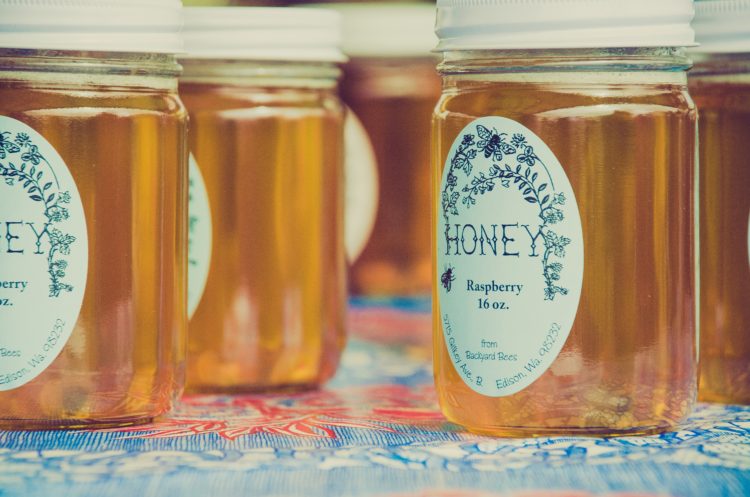“Sugar is sugar is sugar is sugar.”
You may have heard this mantra repeated again and again by a variety of health coaches and low-carb advocates, including us…
But not all sugars are created exactly equal.
“What about honey? Is that okay?” is a very commonly asked question at our Eat by Design seminars.
First off, let’s define what we mean by ‘okay’.
Eat By Design is a strategy to fulfill the food and fuel requirements of the body to optimize health (vs. just not get sick), based on three key criteria:
- Foods we are best adapted to.
- Foods with the highest nutrient density.
- Foods with the least toxicity.
Honey does have some benefits for human health and ancestral studies and ecological studies of modern hunter-gatherer communities suggest that we are well adapted to honey…
However, there are definitely some drawbacks too.
In this article, I’m going to try to sort out the good from the bad, the sweet from the sticky. 🙂
Honey Benefits
Immunity
Raw honey has been shown to have significant benefits for the immune system. A study from Cardiff University showed that eating honey directly increased the number of immune cells produced by the body. Other anecdotal evidence suggests that regularly eating locally sourced honey can improve allergy symptoms in spring.
Wound Healing
Many studies have now shown honey to be effective in the healing of both acute and chronic wounds. In fact, it was a go-to resource even in the time of the Greeks and Romans.
An article published in an international peer-reviewed journal cited 17 randomized controlled clinical trials reporting positive findings for the use of honey in wound care. As a result of this research, honey has been found to have the following properties.
- Infections were not only cleared, but wounds were protected from spreading bacteria.
- Honey controls and eliminates odours from wounds.
- Honey is able to reduce permanent scarring.
- Putting honey on a wound actively reduces inflammation.
Anti-bacterial & Anti-Fungal
Manuka honey, a particular type of honey made from Manuka pollen, has been found to effectively eradicate over 250 different types of bacteria, including MRSA, a particularly resistant strain of harmful bacteria.
All types of honey release hydrogen peroxide, which explains their general anti-bacterial effects, however it seems that Manuka honey has some special ingredient that makes it particularly effective.
Mild Probiotic
Do you know how honey is actually made?
It takes about 60000 bees, visiting around 2 million flowers, just to make ONE POUND of honey. And during that time, it comes into contact with billions of bacteria, including some healthful, ‘good’ bacteria. The bacteria found in some types of honey includes Lactobacillus and Bifido bacteria, two bacterial strains which are commonly found in conventional probiotic supplements.
Sounds like we should all go out and stock up on honey right!?
Not so fast… along with these benefits comes some challenges. Honey can present some significant health and ethical challenges if it is not sourced or delivered properly.
For one thing, honey should never be given to children under the age of 12 months.
In the past there have been some cases of very young children contracting botulism from eating honey.
Infants are still developing their gut flora and natural immune system – it’s not yet ready for everything the world has to throw at it. Older children and adults have the necessary tools and equipment (a sturdier immune system) to neutralize this problem.
There’s also a big difference between raw honey and highly processed or ‘artificial honey’.
Artificial honey is synthetically made from sugar or corn syrups mixed with food additives, preservatives and artificial colours.
Although the ratio of sucrose and fructose (simple sugar molecules) is the same as raw, natural honey, the effects on your body are very different. In one study, supplementation with real honey decreased triglycerides and LDL cholesterol, increased HDL cholesterol, and even decreased plasma homocysteine.
On the contrary, the artificial “honey” raised triglycerides and LDL cholesterol. Other similar studies have found that natural honey results in more stable blood sugar and insulin response when compared with artificial honey following meals.
Eat by Design isn’t a low-carb diet, but rather, it is a carb-appropriate diet.
So, much like fruit, starchy vegetables, nuts and seeds, honey makes the list of By Design foods, BUT just like other carbohydrates need to be matched to the metabolism, and the activity levels of the individual.
Are you ready to turn the page on your unhealthy diet?
Click below to download the Eat By Design Quick Start Guide and get started on the path to a healthier, fitter and more energetic you!
 Dr. David Hawkes is a wellness expert and martial arts enthusiast. Born and raised in Perth, Western Australia, Dr Hawkes’ passion for health and wellness has led him here to Kanata, literally halfway around the world. After graduating from Murdoch University, Dr. Hawkes ran a successful practice in Perth’s western suburbs before moving to Ottawa. Dr. Hawkes has a special interest in family wellness, as well as Peak Performance. He is passionate about helping individuals and families lead their extraordinary lives.
Dr. David Hawkes is a wellness expert and martial arts enthusiast. Born and raised in Perth, Western Australia, Dr Hawkes’ passion for health and wellness has led him here to Kanata, literally halfway around the world. After graduating from Murdoch University, Dr. Hawkes ran a successful practice in Perth’s western suburbs before moving to Ottawa. Dr. Hawkes has a special interest in family wellness, as well as Peak Performance. He is passionate about helping individuals and families lead their extraordinary lives.
